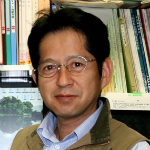
岸本 直文(きしもと なおふみ)
大阪市立大学教授。専門は日本考古学(古墳時代)。博士(文学)。
1964年兵庫県加古川市生まれ。
1991年、京都大学大学院文学研究科博士後期課程中退。
同年より奈良国立文化財研究所。1996年文化庁。2000年より大阪市立大学文学部助教授。准教授を経て現職。
倭国が生まれる古墳時代の成立プロセスや、前方後円墳の形態研究にもとづく前方後円墳共有システムや王権構造の解明、そして古墳時代史を研究する。現在は、これに続く飛鳥時代への転換を考えている。
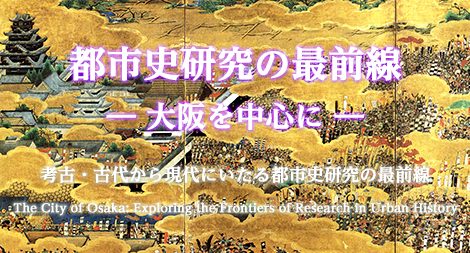
この授業は、私たち、大阪市立大学の教授陣が、考古・古代から現代にいたる都市・大阪の歴史について講義するものです。各時代の特徴的な史資料―文字史料やモノ資料―を手がかりにして、大阪の都市空間や、そこで展開された住民生活とその変遷を、最新の研究成果や方法を用いて解明し、わかりやすく解説します。
この授業では、都市大阪という素材を取り上げます。現在の上町台地周辺は、古代に難波宮という宮殿や都が置かれ、その後も流通上、国際交流上、重要な位置を占め、都市的な性格を持ちつづけ、15世紀末に「大坂」と呼ばれるようになり、秀吉はここに城下町を建設したのです。大阪は、日本の都市の歴史を特徴的に示す古代の都城と、近世の城下町の両方が置かれた都市であり、その間をつなぐ中世の都市ネットワークの存在も、重要です。
文書・絵図など、都市の本当の姿を復元するために欠かせない一次史料や、ビジュアルな素材も意識的に活用し、大阪の歴史像を具体的に明らかにします。さらに、この授業では、大阪歴史博物館を含めた大阪博物館協会とも連携し、何人かのゲストスピーカーにもご登場いただきます。
さらに、この授業には英語の字幕を付けました。日本の都市史研究に興味を抱いている海外の皆さん、日本の大学で日本史や都市史を学ぼうと考えている海外の大学生や院生の皆さんにも見ていただきたいと考えています。
私たちと一緒に、都市大阪の歴史をたどり、日本の都市史研究の最前線を学ぶ旅に出ましょう。

大阪市立大学教授。専門は日本考古学(古墳時代)。博士(文学)。
1964年兵庫県加古川市生まれ。
1991年、京都大学大学院文学研究科博士後期課程中退。
同年より奈良国立文化財研究所。1996年文化庁。2000年より大阪市立大学文学部助教授。准教授を経て現職。
倭国が生まれる古墳時代の成立プロセスや、前方後円墳の形態研究にもとづく前方後円墳共有システムや王権構造の解明、そして古墳時代史を研究する。現在は、これに続く飛鳥時代への転換を考えている。

大阪市立大学准教授。専門は日本古代史。博士(文学)。
1980年京都府生まれ。
2010年、東京大学大学院人文社会系研究科博士課程単位取得退学。
2010年より関東学園大学経済学部講師。2013年より大阪市立大学講師を経て現職。
郡司制度の研究や、古記録の註釈、大阪の古代史を主なテーマとしている。
著書は、『日本古代の郡司と天皇』(吉川弘文館)、『藤原道長事典』(共著、思文閣出版)。
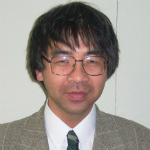
大阪市立大学教授。専門は日本中世史。都市史。博士(文学)。
1962年、大阪府生まれ。
1990年、京都大学大学院文学研究科博士後期課程単位取得退学。
1990年より京都大学文学部助手。1996年より大阪市立大学文学部。助教授などを経て現職。
日本中世都市史を、文献史を中心に、考古学・歴史地理学の成果を活用して学際的に研究している。
近年は特に、城下町、宗教都市の研究に取り組んでいる。
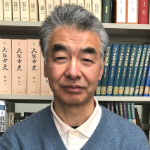
大阪市立大学教授。専門は日本近世史。都市社会史。博士(文学)。
1954年福井県生まれ。
1978年、東京大学文学部卒業。
1979年より東京大学史料編纂所の助手。1988年より大阪市立大学文学部講師。助教授を経て現職。
専門は日本近世史。近世日本の身分制や都市史、地域史を広く手がける。大坂の都市社会史研究は大きな柱の一つ。著書は『近世大坂の都市社会』(吉川弘文館)、『近世大坂の非人と身分的周縁』(部落問題研究所)、『都市社会史の視点と構想』(清文堂)など多数。

大阪市立大学教授。専門は日本近現代史。都市社会史。博士(文学)。
1966年大阪生まれ。
1997年、大阪市立大学大学院文学研究科後期博士課程単位取得退学。
1999年より桃山学院大学文学部専任講師、のち経済学部助教授。2010年より大阪市立大学准教授を経て現職。
近代大阪の都市社会史・地域史をテーマに、大阪の民衆生活の復元に取り組んでいる。近年は、近世~近代における「遊廓社会」の共同研究も進めている。
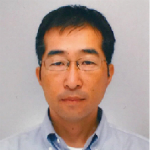
公益財団法人大阪市博物館協会大阪歴史博物館主任学芸員。
1997年、関西大学大学院工学研究科建築学専攻博士後期課程修了。博士(工学)。
1997年、財団法人大阪市文化財協会調査研究部学芸員を経て、現職。

大阪府堺市出身。
1999年、大阪市立大学大学院文学研究科後期博士課程単位取得退学。博士(文学)。
近世大坂の薬種中買仲間と西日本における薬種流通について研究を進めている。著書に『近世大坂薬種の取引構造と社会集団』(清文堂出版、2006年)がある。
現在、頭脳循環プログラム「周縁的社会集団と近代―日本と欧米におけるアジア史研究の架橋」の研究補佐。

大阪市立大学大学院文学研究科後期博士課程在学中。日本学術振興会特別研究員DC1。中国人留学生。
専門は日本近世都市史。現在は、大坂の道修町三丁目を対象として、近世大坂の町(ちょう)の研究を進めている。
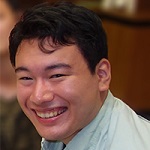
大阪市立大学大学院文学研究科後期博士課程在学中。専門は戦国時代。
都市を取り巻く大名、寺社、地域領主ら諸権力の関係について研究を行っている。
特になし
毎週のテストと、最終テストを課します。
得点率60%以上
4週間
講義動画収録時期:2018年
カテゴリーⅢ![]()
In this course, a group of Osaka City University lecturers sheds light on the history of urban Osaka from prehistory and antiquity to the present, making free use of a diverse range of historical sources, including visual materials, to introduce you to research in urban history at the cutting edge.
In this course, we, the Japanese history faculty, will give a series of lectures covering the history of the city of Osaka, from prehistory to present. With representative source materials—textual records as well as objects—from each historical period pointing the way, we will use the latest scholarly research and methodologies to elucidate and interpret the urban spatial structures through which the people of Osaka lived their lives.
To illustrate such lives concretely, this course looks to the city of Osaka. In the ancient period, the Uemachi Plateau, which sits at the center of the city today, served for a time as the site of the imperial palace (Naniwanomiya) and, therefore, the capital. The area thus became a primary node for the circulation of goods and people, as well as for international relations. It continued as an urban space even after the capital moved, came to be called “Osaka” from the end of the fifteenth century, and eventually Hideyoshi (1537-1598) chose it as his seat of power, constructing the massive Osaka Castle and building up the surrounding town. Thus Osaka is a city that represents the two classic urban forms in Japanese history: the Chinese-style capital of the ancient period and the castle town of the early modern period, with the gap between them, importantly, bridged by the medieval period’s city networks.
In this course, we’ll shine light on Osaka’s history through on-the-ground examples, making full use of the texts, illustrations, and other primary sources and visual materials that together allow us to reconstruct the true shape of the city’s past. In bringing together the material for the class, we’ve worked with researchers from other institutions, such as the Osaka Museum of History, and along the way a number of them will join us as guest speakers. To make the course available to a wider audience, we’ve also prepared English subtitles for each lecture. We very much hope that the course will reach people overseas with an interest in Japan’s urban history, especially international undergraduate and graduate students who might be considering studying urban or Japanese history at a university in Japan.
With that, let’s get started on our journey, following the frontiers of urban historical research in Japan through the twists and turns of Osaka’s past.

Professor, Osaka City University; specialist field: Archaeology of Japan (Kofun period); PhD. (Lit.)
1964: Born in Kakogawa City, Hyogo Prefecture
1991: Retired from postdoctoral research on Literature at Kyoto University Graduate School of Letters, joining the Nara National Research Institute for Cultural Properties the same year; joined the Agency for Cultural Affairs in 1996; 2000: Assistant Professor, Faculty of Letters, Osaka City University, subsequently progressing from Associate Professor to Professor
Research interests: Prof. Kishimoto is researching the formation process of the Kofun period, during which the state of Wa was born, and elucidating the construction of royal authority through examining the system of shared ownership of keyhole-shaped tumuli on the basis of morphological research on these tumuli. He is also researching the history of the Kofun period and is presently contemplating progressing on to research the Asuka period.

Associate Professor, Osaka City University; specialist field: History of Ancient Japan; PhD. (Lit.)
1980: Born in Kyoto Prefecture
2010: Completed postdoctoral studies at University of Tokyo Graduate School of Humanities and Social Sciences
2010: Lecturer, Faculty of Economics, Kanto Gakuen University; from 2013, progressed from Lecturer at Osaka City University to Associate Professor
Research interests: The system of Governorships [in ancient Japan], annotating ancient texts, and the history of ancient Osaka
Publications include: Nihon kodai no gunji to tennō (Governors and Emperors in Ancient Japan), Yoshikawa Kōbunkan and Fujiwara no Michinaga jiten (An Encyclopedia of Fujiwara no Michinaga), co-authored, Shibunkaku Shuppan

Professor, Osaka City University; specialist fields: History of Medieval Japan, Urban History; PhD. (Lit.)
1962: Born in Osaka Prefecture
1990: Completed postdoctoral studies at Kyoto University Graduate School of Letters
1990: Assistant, Kyoto University Graduate School of Letters; from 1996, progressed from Assistant Professor, Faculty of Letters, Osaka City University, etc., to Professor
Research interests: Taking an interdisciplinary approach to researching the urban history of medieval Japan, Dr. Niki concentrates on documentary sources while drawing on research findings in archaeology and historical geography.
In recent years, he has been concentrating especially on castle towns and urban religious settlements.

Professor, Osaka City University; specialist fields: Early Modern History of Japan, Urban Social History; PhD. (Lit.)
1954: Born in Fukui Prefecture
1978: Graduated from Faculty of Letters, University of Tokyo
1979: Assistant, Historiographical Institute of the University of Tokyo; 1988: Lecturer, Faculty of Letters, Osaka City University, subsequently progressing from Assistant Professor to Professor
Specialist field: Early Modern History of Japan
Research interests: Prof. Tsukuda covers a broad range of interests, including the class system and urban history of early modern Japan, along with regional history. The urban social history of Osaka is a major pillar of his research. Publications include: Kinsei Osaka no toshi shakai (Urban Society in Early Modern Osaka),Yoshikawa Kōbunkan, Kinsei Osaka no hinin to mibunteki shūen (The Underclass and Social Fringes in Early Modern Osaka), The Institute of the Burakumin Problem, and Toshi shakai no shiten to kōsō (Perspectives and Concepts of Urban Society), Seibundō, among numerous others

Professor, Osaka City University; specialist fields: History of Modern Japan, Urban Social History; PhD. (Lit.)
1966: Born in Osaka
1997: Completed postdoctoral studies at Osaka City University Graduate School of Letters
1999: Full-time Lecturer, Faculty of Letters, Momoyama Gakuin University, and subsequently Assistant Professor at the Faculty of Economics; from 2010, progressed from Associate Professor, Osaka City University, to Professor
Research interests: Taking the urban social and regional history of modern Osaka as themes, Prof. Saga is engaged in reconstructing the lives of the common people of Osaka. In recent years, Prof. Saga also been collaborating in research on society in the brothel districts from the early modern into the modern period.

Chief Curator, Osaka Museum of History
1997: Completed postdoctoral studies in Architecture at the Postgraduate School of Science and Engineering, Kansai University; PhD. (Eng.)
1997: Progressed from Curator, Survey and Research Section, Osaka City Cultural Properties Association to Chief Curator, Osaka Museum of History

From Sakai City, Osaka Prefecture
1999: Completed postdoctoral studies at Osaka City University Graduate School of Letters; PhD. (Lit.)
Research interests: Dr. Watanabe is researching the drug wholesaler’s guild in early modern Osaka, along with the distribution of drugs in Western Japan.
Publications include: Kinsei Osaka yakushu no torihiki kōzō to shakai shūdan (Social Groups and the Structure of the Trade in Drugs in Early Modern Osaka), Seibundō Shuppan, 2006
At present, Dr. Watanabe is a Research Assistant on the Program for Advancing Strategic International Networks to Accelerate the Circulation of Talented Researchers for the research theme of Marginal Social Groups’ Experiences of Modernity: Building Bridges between Historians of Asia in Japan and the West.

Engaged in postdoctoral studies at Osaka City University Graduate School of Letters; JSPS Research Fellowship for Young Scientists (DC 1 ); An International student from China;
Research interests: Early Modern Urban History of Japan;He is researching the early modern chō by focusing on the neighborhood of Doshōmachi sanchō-me in Osaka.

Engaged in postdoctoral studies at Osaka City University Graduate School of Letters; specialist field: Sengoku period; researching about the relationship of power such as the Daimyo, temples, and local loads surrounding the city.
No specific requirements.
All lectures will be delivered in Japanese with Japanese and English captions, allowing non-Japanese speakers to audit the course.
Weekly quizzes and a final quiz with multiple choice questions.
Quizzes may be taken either in Japanese or English.
60% score or higher
4Weeks
※受講登録するとお客様の利用者情報は講座提供者(講師)に共有されます。詳しくは利用規約とプライバシーポリシーをご覧ください。